Timber Flooring in NZ: Where it Began & Where We Are Now
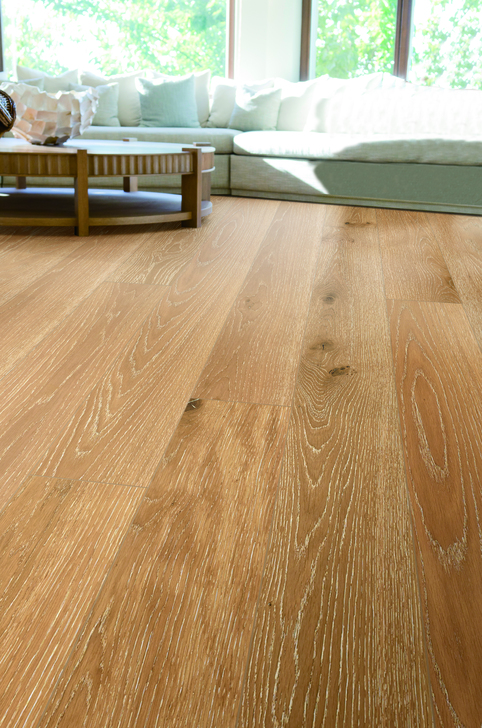
Posted October 25, 2023
Timber Flooring. Loved by Kiwis throughout the country, for many of us it takes us back to our childhood homes where matai and rimu graced the floors of the houses built in the 1940’s and 1950’s. Since then, many advances have been made in timber flooring in terms of sustainability, performance and installation meaning there are now more options than ever. Let’s take a look at where timber flooring started here in NZ and where it is now.
Matai and Rimu flooring were extremely popular choices for flooring in homes built throughout New Zealand in the 1940’s and 1950’s. Our forests were abundant with native species that provided durable and stunning timber ideal for flooring. Sadly, during this time, care was not taken to ensure that these timbers were being felled in a sustainable way. This led to The Forests Act coming into force in 1949 which was the beginning of the end for native timbers being the first choice for flooring. However, since these changes many rimu and matai floors throughout the country have been lovingly restored providing a small glimpse into the history and iconic style of some of our classic Kiwi homes. This continues today as many villas and bungalows are renovated and the treasure of stunning native timber flooring is often discovered underneath old carpet or sheet vinyl.
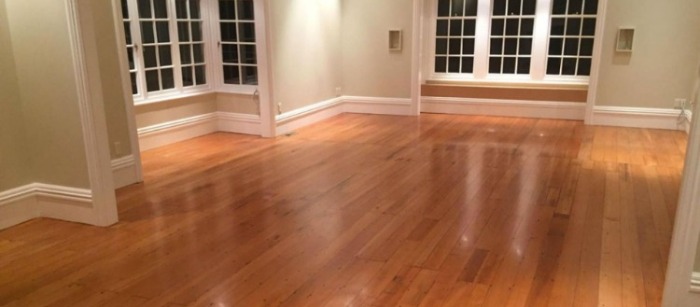

Many classic homes throughout New Zealand have had their old rimu flooring lovingly restored back to it's former glory. Rimu forests have been protected under The Forests Act since 1949 to ensure native species do not become extinct.
In recent decades, native timber reclaimed from demolition sites and house removal projects was available however demand was extremely high which inevitably created supply issues. There is now very little of this recycled native timber available, perhaps the odd house lot here and there found at a demolition yard or recycled building materials supplier. Solid timber flooring is certainly still an option but those wanting this in their home now have to choose from non-native species. Here at The Flooring Centre we can advise on and source nearly any species of timber suitable for flooring use. We only source and supply timber from sustainably managed forests as part of our commitment to the environment. Solid timber flooring is the most expensive of all timber flooring options due to the material required as well as the specialist installation process involved. We have a team of skilled craftsmen knowledgeable in solid timber flooring installation, from floor preparation right through to sanding and sealing.
Engineered timber flooring has had quite the journey of development in arriving at what we have today. It’s very earliest history actually dates back to the 19th century when the concept was first used in the construction of ships and aeroplanes. The 1930’s saw the introduction of plywood – thin layers of wood glued together in a cross laminate configuration providing greater stability when compared to solid timber. Laminate and floating floors emerged in the 1980’s and 1990’s as manufacturing technologies advanced. These products combined timber and synthetic materials making them more affordable and easier to install than traditional solid timber flooring. All of these developments have ultimately led us to the engineered timber flooring we have currently which is ultimately a combination of the learnings and progress in the industry over the last century.
Modern engineered timber flooring is constructed from layers of wood that are fused together. This starts with a backing layer, and then a core board usually made of Pine or Hevea which absorbs stress and strain and ensures that the timber remains stable in almost any condition. On top of this is a solid timber layer available in an extensive array of colours and grains which is enhanced and protected by 5-7 coats of polyurethane. Engineered timber flooring offers the unique look and character of a solid timber floor with the very latest technology making it an extremely stable and durable. It is also a lot more straightforward and quicker to install. Unlike solid timber flooring, engineered timber flooring does not require on site sanding or polyurethane application meaning minimal disruption for you and your home. We only source and sell quality products from reputable manufacturers with patented locking systems. This ensures the joints between boards remain firm and stable so you don’t have to worry about warping. Our suppliers offer comprehensive guarantees covering construction and wear giving you peace of mind.
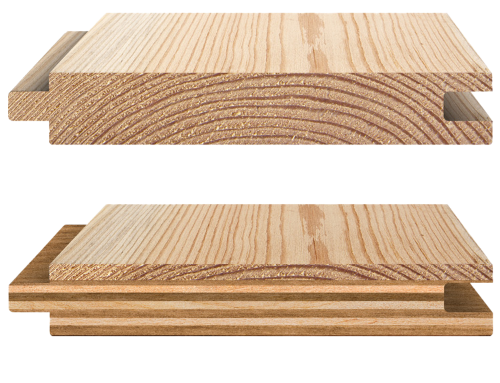
The images above show the difference between solid timber flooring (top image) and engineered timber flooring (bottom image). As can be seen, solid timber is one piece of timber where as engineered timber is many layers of different timbers fused together.
Engineered timber flooring can be installed one of two ways – “floating floor” method or “direct stick” method. The floating method works by using the click together system and so the floor “floats” and is not fixed down to the subfloor. This allows for a much quicker installation and consequently costs less. However this method means the floor is more likely to move (timber is a product that expands and contracts with temperature and humidity fluctuations) and will sound hollow or “drummy”. Floating floors cannot be re-sanded or installed under kitchen cupboards. They also require more trims as well as larger ones between different floor coverings and for any window or door joinery that is at floor level. These trims can be unsightly and disrupt the continuity of the flooring.
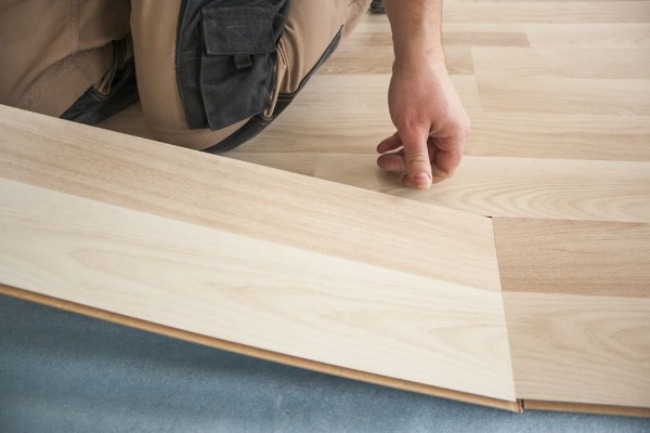
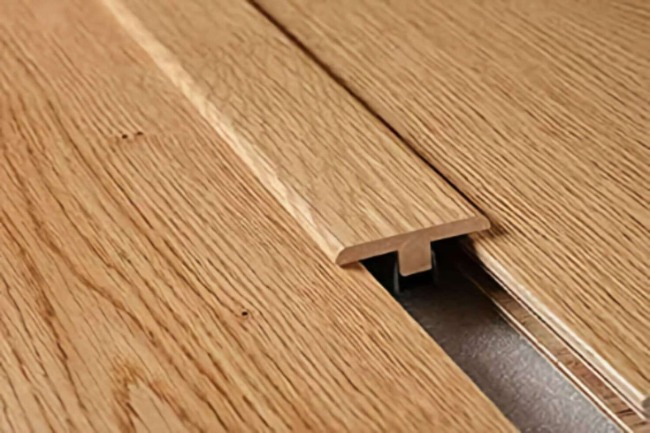
The "floating floor" method allows for quicker installation but often leads to more movement and can sound "drummy". It also requires more transition trims which can be unsightly and disrupt the continuity of the flooring.
Direct stick, as the name suggests involves gluing the boards directly to the subfloor, in most instances this is recommended as it is a better installation method for a myriad of reasons. Direct stick allows you to re-sand your floor, provides a solid feel underfoot as well as superior acoustic performance. It also means changes in temperature and humidity won’t affect the flooring as much as if it were floating, limiting the amount of movement. Kitchen cabinetry can be installed over timber flooring that is glued down and is best for underfloor heating as it ensures better heat transfer.
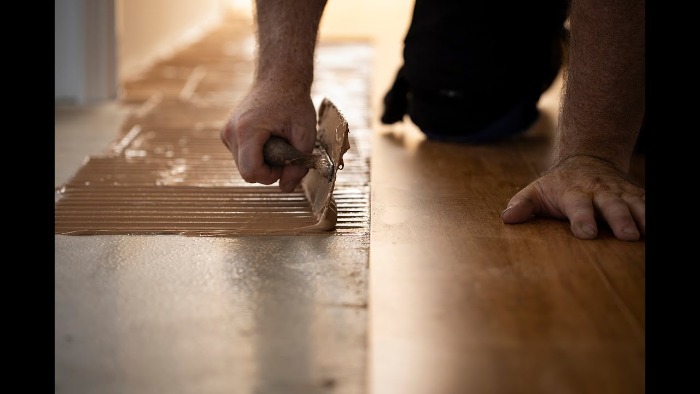
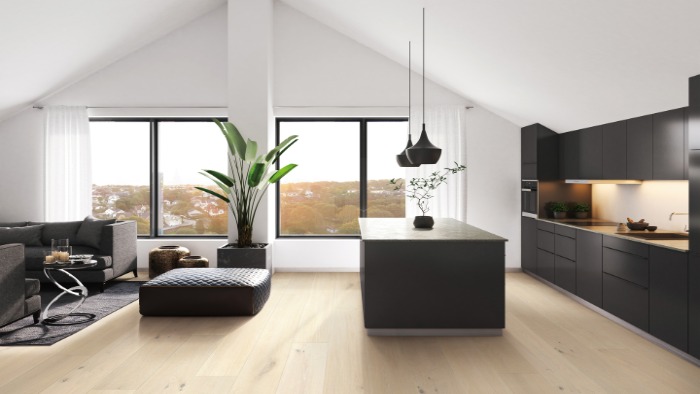
The "direct stick" method takes longer but provides a superior finish overall with better feel underfoot, improved acoustic performance and far less movement. The end result is a stunning floor that will last for years to come.
Timber flooring in New Zealand has quite the history and still remains a popular choice in homes today. It offers character and a unique aesthetic that try as they might, other types of hard flooring simply cannot replicate. If you’re thinking about timber flooring for your home – whether solid or engineered, our team can help guide you through the process and answer your questions – they really know their stuff! Pop in and see us, get in touch or view our great timber flooring options below!
